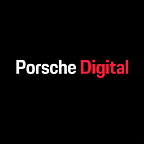From 2D to 3D and Back: How we Digitize Vehicle Foiling
By any means, cars are some of the most individualized products. Not to forget the remarkable relationship most car owners have to their “product”. For most of us, a car stays with us much longer than many other things we own. And yet, the design of a car — despite its unmistakable importance in terms of appearance — is not exactly unique, in the sense that each model comes in a limited choice of colors. There is, in other words, only so much variation possible. To make the car even more customizable and individual, we at Porsche Digital got curious about the field of vehicle foiling.
A traditional industry branch that lacks digitization
Vehicle foiling has grown in popularity in recent years and proven to be a real alternative to a traditional paint job. A perfect custom-made foil design can go a long way in maximizing the car’s visual impact. However, the car foiling business is still in its infancy in terms of digital sophistication and know-how.
Usually, cars are being foiled for a special design. Foiling a whole color is no problem as you can simply cut off the overlapping foil. It’s becoming way more complex when the special design is supposed to interact with and resemble the shape, dynamics, and forms of the car.
Why? Traditional foiling shops design the foiling based on a side and top view sketch of the model in a program such as Adobe Illustrator. Based on the design, vectors, colors and all relevant printing data is exported for the final foil. This all happens in two dimensions.
But cars are three-dimensional objects. For example, the Porsche 911 is known for its winding shape with many arches. A high-quality foiling must conform to the curves, contours and complex shapes of the car, which makes designing a perfect foil especially for this car very complex.
Design made in 2D vs. curvy cars in 3D
This is a fundamental issue in traditional car foiling: When applying the foil onto the vehicle, it often doesn’t fit perfectly and needs multiple test foilings. This is because of the gap between the dimensions — the individual curves and arches of the model cannot be included in the 2D design, which often results in several runs to perfect the foiling measurements and consequently, more waste and resources needed. Currently, foiling experts try to compensate the margin between the dimensions by their experience.
We at Porsche Digital were convinced that there must be a technical solution for this problem — and solved it by digitalizing the design and manufacturing processes of car foiling.
Bringing vehicle foiling to the next level with Second Skin
With Second Skin, we design the foiling on a 3D model of the car, which enables us to integrate the shapes and forms of the car into the design right from the start. This way, the customer immediately gets a realistic impression of what the car will look like — as you can see for yourself in the online configurator. They can look at the unique layout of their particular vehicle and further edit the designs and colors together with our designers, and somehow become the designer of their individual car themselves.
A digital tool to convert data between dimensions
We developed a digital tool that makes the transfer from 3D to 2D possible, enabling us to transform the 3D visualizations into printing data and produce foilings that perfectly fit the shape of the car.
And this is how it works: To create design shapes that fit the body lines perfectly, we take a high detail original CAD geometry of the car and do so-called “unwrapping”. As the name suggests, it is the exact inverted process of wrapping. You could imagine it like taking an already wrapped car, carefully removing the foil and then spreading it flat on the ground. It is commonly used in 3D animation and game design to apply 2D art on 3D objects. However, the existing tools and workflows that are usually integrated in 3D modeling software did not provide the level of accuracy we needed. So we developed our own plugins and interfaces that are tailored to the specific use case of car wrapping. This also enables us to export both high-quality vector layouts for print shops and simpler pixel-based textures that can easily be viewed in a web browser without performance issues.
With Second Skin, we leverage the potential of digital technologies to bring vehicle foiling to the next level. We specialized in high-quality 3D design and visualization and offer a state-of-the-art car foiling service that delivers a premium paint-like finish to vehicles. Have a look at foiling we’ve already done, our current collections and learn more about our service on the website. We’re ready to make car ownership even more customized!
Moritz Hornung (l.) is responsible for User Experience Concepts & Prototyping at Porsche Digital.
Simeon Herrmann (r.) is User Experience Designer at Porsche Digital.
About this publication: Where innovation meets tradition. There’s more to Porsche than sports cars — we’re tackling new challenges, develop digital products and think digital with a focus on the customer. On our Medium blog, we tell these stories. It’s about our #nextvisions, smart technologies and the people that drive our digital journey. Please follow us on Twitter (Porsche Digital, Next Visions), Instagram (Porsche Digital, Next Visions, Porsche Newsroom) and LinkedIn (Porsche AG, Porsche Digital) for more.
